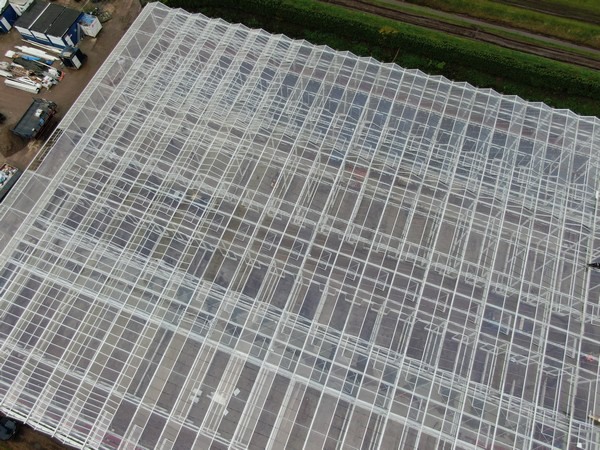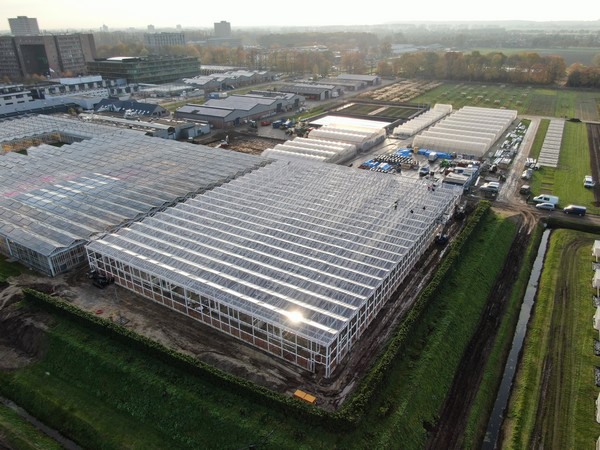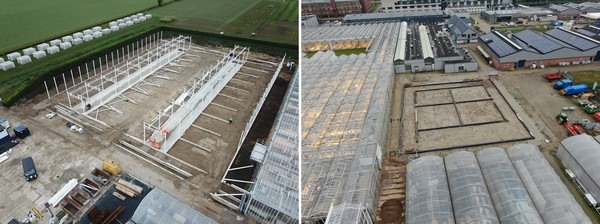A ‘green’ university obviously also wants ‘green’ greenhouses. For this reason, construction started on a one hundred percent electrical ‘high containment’ research greenhouse on the campus of Wageningen University & Research at the start of 2019.

Right before Christmas, the greenhouse was fully glazed, so it is now time to furnish the inside of the greenhouse. A special job, seeing as all of the technology is located in the basement. “One of the wishes of the researchers who wanted as little shadow as possible in the greenhouse”, says Patrick Hollemans of Bosman Van Zaal, which after a tender was chosen to be the main contractor.
The first phase before the renovation of the greenhouse complex at Unifarm consists of four thousand square meters of greenhouse with 63 (!) compartments in it. These vary in size from 16 to 50 square meters.

Each of the compartments can be controlled individually in terms of climate, lighting (in anticipation of the latest developments in the field of LED lighting), and water. This is thanks to the use of their own heating, cooling, and under- and overpressure. However, this does require good isolation, because the compartments in the complex will be used for different types of research next to each other, and these research projects cannot interfere with each other.

The start of construction at the beginning of 2019
Basements
The technology that does not need to be hung in the greenhouse has been kept outside of the cultivation space. Thanks to that, maintenance and repair can be conducted more easily, as well as the cleaning of the individual compartments. However, letting in natural light was the most important reason.
“Two basement floors have been made as technical corridors underneath the concrete floor”, Patrick explains. “The three remaining corridors are accessible to the researchers and the students, and two of the corridors are technical corridors. The basements are closed off with metal gratings where the people above the basement can walk on.”

View of the basements
A combination of glass types and coatings
Besides the basement the greenhouse is equipped with, the glass used is also notable. Due to the double glazing, the greenhouses, which also have a Heat Cold Storage Installation and a low-temperature network, is extra energy efficient.
Glass supplier Glasimport Greenhouses provided the glass. Jorn Hebels, account manager at the company located in the Dutch Westland, says how through cooperating with different glass manufacturers, the company was able to come up with a full proposal for the project.
For the inner façade, the choice was made to go for single tempered float glass of 6 mm thick. For the outer façade as well as the greenhouse cover, a 22 mm thick insulation glass with a high insulating value combined with high light transmissibility was chosen.
“Thanks to the combination of LowE and Anti-reflex coatings with a low-iron glass, the light transmissibility is very high”, says Jorn, “while the double insulation glass also has a high insulating value which leads to a significant reduction in energy costs.”
The special edge sealing of the glass is also sustainable, says Jorn. “It’s resistant against high levels of sunlight (UV radiation), temperature swings, humidity, and mechanical pressure.”

Steel work underway
Highly efficient glass that can take a beating
By using tempered glass both indoor and outdoor, the greenhouse, according to both Jorn and Ruud Geerlings of glass producer Scheuten Glas, is very safe for employees, plants, and the equipment inside.
Ruud, who delivered the insulation glass: “This greenhouse cover technology is ready for the future in every way. The greenhouse horticulture is being inspected closely in terms of sustainability (energy use), safety, and light output to promote plant growth.
"The ultimate goal is to reach as high as possible efficiency with as little as possible energy (loss), all of which needs to be done in a safe way. This was a big success in the project, making it an excellent example for further developments in the field of sustainable greenhouse horticulture.”
On Friday, the 7th of February, the symbolic highest point of the greenhouse was reached, and that had to be celebrated.

Celebration of the highest point at WUR
For more information:
Bosman Van Zaal
info@bosmanvanzaal.com
www.bosmanvanzaal.com
